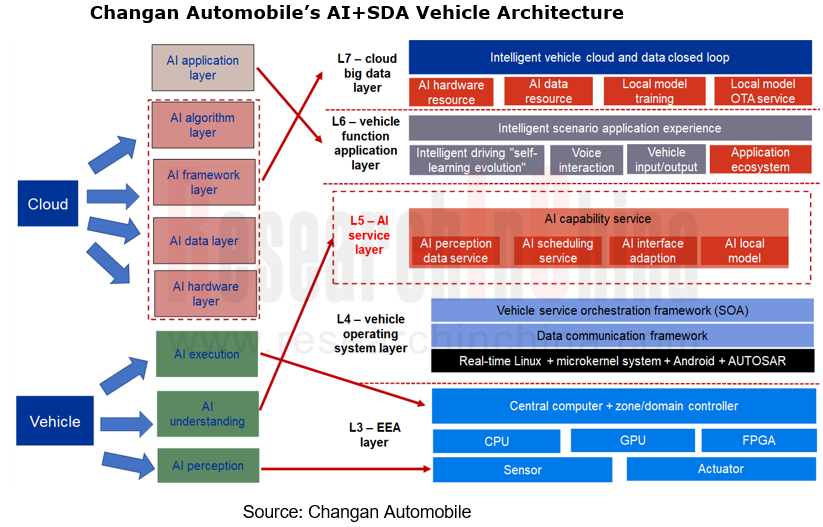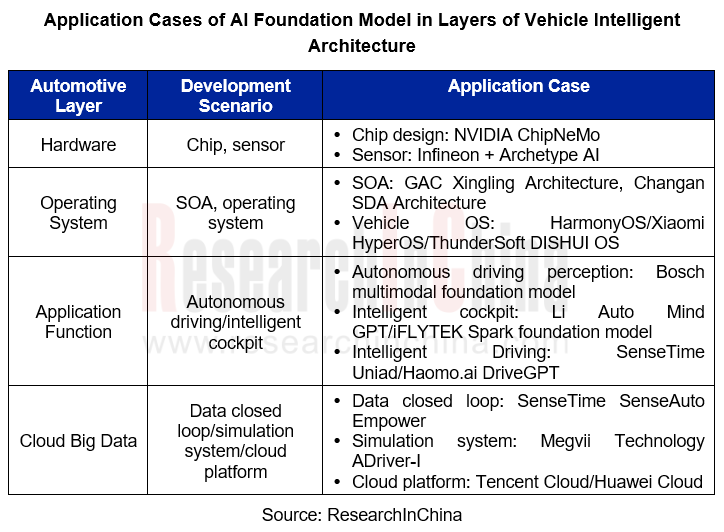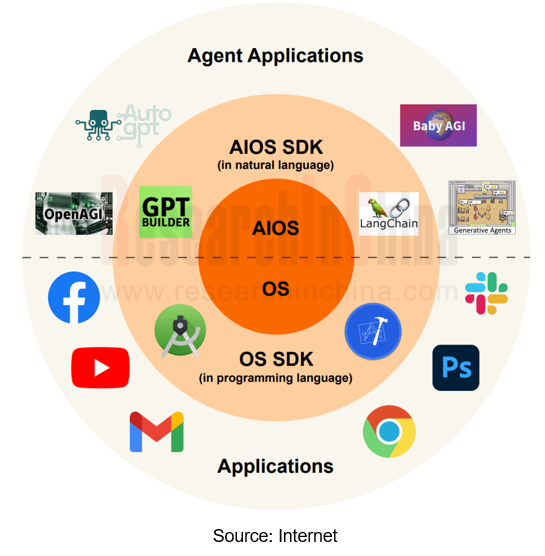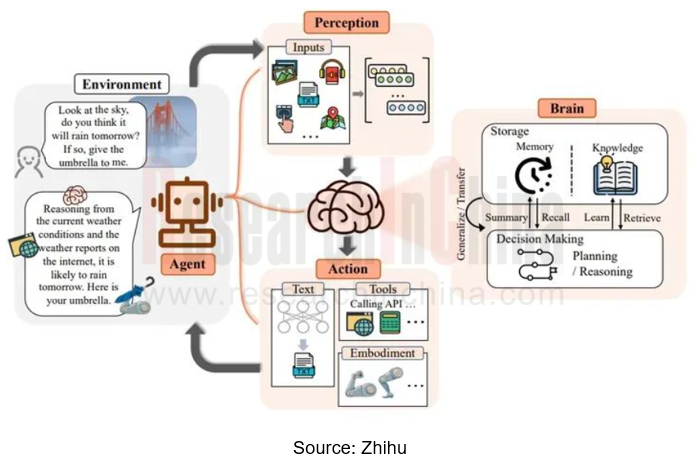AI Foundation Models’ Impacts on Vehicle Intelligent Design and Development Research Report, 2024
AI foundation models are booming. The launch of ChapGPT and SORA is shocking. Scientists and entrepreneurs at AI frontier point out that AI foundation models will rebuild all walks of life, especially tech-related fields. As a technological product, how will intelligent vehicles be changed by AI foundation models?
How foundation models will rebuild intelligent vehicles?
Following the "Automotive AI Foundation Model Technology and Application Trends Report, 2023-2024", a report which discusses impacts of AI foundation models on automotive industry from a macro perspective, ResearchInChina released the "AI Foundation Models’ Impacts on Vehicle Intelligent Design and Development Research Report, 2024", the second report which researches the impacts of AI foundation models on vehicle intelligent design and development in the such aspects as hardware, operating system, application function, and cloud big data.
In 2023, Changan Automobile added AI edge and AI service layer to the original software-driven architecture (SDA) that includes L1-L6 layers. It can be seen that AI technology has affected most layers of intelligent vehicles: L3 EEA layer, L4 vehicle OS layer, L6 vehicle function application layer (including cockpit, connectivity and intelligent driving), L7 cloud big data layer, etc. The chassis part of L1 mechanical layer and the battery part of L2 power layer have actually involved AI application.

Currently, OEMs and Tier1s apply foundation models to part of vehicle intelligence, or to some link in the development process.

When viewing the general application trend of AI foundation models in vehicles, we also need to find an idea in the evolution of foundation models. According to the results of Tencent Research Institute, AI will evolve from the brain to AI Agent, and from CoPilot to autonomous driving.
So, what is AI Agent?
Will foundation model/AI Agent replace OS/APP?
ResearchInChina accepts the view: AI foundation model is the OS, and AI Agent is the application. The development paradigm of intelligent products will be changed from conventional OS-APP ecosystem paradigm to AI foundation model-AI Agent ecosystem paradigm.

What is AI Agent? It is an artificial intelligence (AI) system beyond simple text generation. AI Agent uses a large language model (LLM) as its core computing engine, so that it can make conversations, perform tasks, make inferences, and have a degree of autonomy. In short, AI Agent is a system with complex reasoning capabilities, memory and task execution methods. It is thus clear that NOMI GPT in NIO’s cockpit and Tesla FSD V12 are AI Agents in the cockpit domain and intelligent driving domain, respectively.

AI foundation models, a platform-level AI technology, include those launched by first-tier technology companies, such as ChatGPT and ERNIE Bot. Platform-level AI can serve as the technological foundation to empower operating systems in all aspects. It is regarded as the new kernel of next-generation operating systems. The kernel of conventional operating systems is mainly responsible for managing and scheduling the system's hardware resources like GPU and memory to ensure normal operation and efficient utilization of system. Yet with increasing user demand, AI systems need to parse many human-related personalized experiences.
For personal knowledge base, people's location and status awareness, people's habits and hobbies and other personalization factors, conventional operating systems fall short of effective calculation and processing. We thus need a brand-new kernel to meet these requirements. The strength of platform-level AI foundation models is that they can manage and process multiple personal factors and help the operating system accurately recognize user intents. With such capabilities, fire-new operating systems can bring everyone an intelligent experience of “guess what you want and understand what you need.”
In automotive cockpit applications, to achieve true personalization, automakers also need to further customize the AI foundation model according to the features of their own vehicle models and services, that is, AI Agent based on platform-level AI foundation model. We can see that Geely models (such as Jiyue and Galaxy) are based on Baidu ERNIE Bot-based cockpit systems, and Mercedes-Benz's in-car voice assistant are actually an AI Agent after being connected to ChatGPT.
At present, intelligent driving AI Agent and cockpit AI Agent are separate. As cockpit-driving integration develops, they will tend to be integrated. However when considering cockpit-driving integration, OEMs and Tier1s cannot only consider integration at the hardware level, but also need to take into account operating system and vehicle system architecture, especially rapid evolution of foundation models/AI Agent models.
Foundation model/AI Agent is currently a part of an operating system/APP ecosystem. Will it replace operating systems/APP models in the future? We think it's possible.
Foundation model-based agents will not only allow everyone to have an exclusive intelligent assistant with enhanced capabilities, but also change the mode of human-machine cooperation and bring broader human-machine fusion. There are three human-AI cooperation modes: Embedding, Copilot, and Agent.
In intelligent driving, the Embedding mode is equivalent to L1-L2 autonomous driving; the Copilot mode, L2.5 and highway NOA; the Agent mode, urban NOA and L3 autonomous driving.
In the Agent mode, humans set goals and provide necessary resources (e.g., computing power), then AI independently undertakes most of tasks, and finally humans supervise the process and evaluate the final results. In this mode, AI fully embodies the interactive, autonomous and adaptable characteristics of Agents and is close to an independent actor, while humans play more of a supervisor and evaluator role.
A large number of interactive operations that were originally enabled via IVI APP can now be achieved through natural interactions (voice, gesture, etc.) in the AI Agent mode. AI Agent even actively observes the inside and outside of the vehicle, makes a request inquiry, and can perform a task after being confirmed by the user.
Therefore, the development of AI Agent is bound to make a mass of previous apps unnecessary and will have a disruptive impact on the development and application of intelligent cockpit and intelligent driving.
The current AI foundation models are not an operating system, but a paradigm and architecture of AI models, focusing on how to enable machines to process multimodal data (text, image, video, etc.). AI Agent is more similar to an AI application or application layer, which requires the support of the underlying operating system and hardware for operation. It is not in itself responsible for the basic management and resource scheduling of the computer system. In the future, AI foundation models are likely to be combined with OS to become AIOS.
AI foundation models and AI Agent development have the following impacts on future operating systems:
Applets will disappear or evolve into AI Agent that calls foundation models;
OS may evolve into the foundation model + computing chip core cluster OS architecture;
AI foundation models as a platform redefine and empower all kinds of industrial application scenarios, and give rise to more human-computer interaction-centric native applications, including autonomous vehicles, robots and digital twin applications.
Autonomous Driving Domain Controller and Central Computing Unit (CCU) Industry Report, 2025
Research on Autonomous Driving Domain Controllers: Monthly Penetration Rate Exceeded 30% for the First Time, and 700T+ Ultrahigh-compute Domain Controller Products Are Rapidly Installed in Vehicles
L...
China Automotive Lighting and Ambient Lighting System Research Report, 2025
Automotive Lighting System Research: In 2025H1, Autonomous Driving System (ADS) Marker Lamps Saw an 11-Fold Year-on-Year Growth and the Installation Rate of Automotive LED Lighting Approached 90...
Ecological Domain and Automotive Hardware Expansion Research Report, 2025
ResearchInChina has released the Ecological Domain and Automotive Hardware Expansion Research Report, 2025, which delves into the application of various automotive extended hardware, supplier ecologic...
Automotive Seating Innovation Technology Trend Research Report, 2025
Automotive Seating Research: With Popularization of Comfort Functions, How to Properly "Stack Functions" for Seating?
This report studies the status quo of seating technologies and functions in aspe...
Research Report on Chinese Suppliers’ Overseas Layout of Intelligent Driving, 2025
Research on Overseas Layout of Intelligent Driving: There Are Multiple Challenges in Overseas Layout, and Light-Asset Cooperation with Foreign Suppliers Emerges as the Optimal Solution at Present
20...
High-Voltage Power Supply in New Energy Vehicle (BMS, BDU, Relay, Integrated Battery Box) Research Report, 2025
The high-voltage power supply system is a core component of new energy vehicles. The battery pack serves as the central energy source, with the capacity of power battery affecting the vehicle's range,...
Automotive Radio Frequency System-on-Chip (RF SoC) and Module Research Report, 2025
Automotive RF SoC Research: The Pace of Introducing "Nerve Endings" such as UWB, NTN Satellite Communication, NearLink, and WIFI into Intelligent Vehicles Quickens
RF SoC (Radio Frequency Syst...
Automotive Power Management ICs and Signal Chain Chips Industry Research Report, 2025
Analog chips are used to process continuous analog signals from the natural world, such as light, sound, electricity/magnetism, position/speed/acceleration, and temperature. They are mainly composed o...
Global and China Electronic Rearview Mirror Industry Report, 2025
Based on the installation location, electronic rearview mirrors can be divided into electronic interior rearview mirrors (i.e., streaming media rearview mirrors) and electronic exterior rearview mirro...
Intelligent Cockpit Tier 1 Supplier Research Report, 2025 (Chinese Companies)
Intelligent Cockpit Tier1 Suppliers Research: Emerging AI Cockpit Products Fuel Layout of Full-Scenario Cockpit Ecosystem
This report mainly analyzes the current layout, innovative products, and deve...
Next-generation Central and Zonal Communication Network Topology and Chip Industry Research Report, 2025
The automotive E/E architecture is evolving towards a "central computing + zonal control" architecture, where the central computing platform is responsible for high-computing-power tasks, and zonal co...
Vehicle-road-cloud Integration and C-V2X Industry Research Report, 2025
Vehicle-side C-V2X Application Scenarios: Transition from R16 to R17, Providing a Communication Base for High-level Autonomous Driving, with the C-V2X On-board Explosion Period Approaching
In 2024, t...
Intelligent Cockpit Patent Analysis Report, 2025
Patent Trend: Three Major Directions of Intelligent Cockpits in 2025
This report explores the development trends of cutting-edge intelligent cockpits from the perspective of patents. The research sco...
Smart Car Information Security (Cybersecurity and Data Security) Research Report, 2025
Research on Automotive Information Security: AI Fusion Intelligent Protection and Ecological Collaboration Ensure Cybersecurity and Data Security
At present, what are the security risks faced by inte...
New Energy Vehicle 800-1000V High-Voltage Architecture and Supply Chain Research Report, 2025
Research on 800-1000V Architecture: to be installed in over 7 million vehicles in 2030, marking the arrival of the era of full-domain high voltage and megawatt supercharging.
In 2025, the 800-1000V h...
Foreign Tier 1 ADAS Suppliers Industry Research Report 2025
Research on Overseas Tier 1 ADAS Suppliers: Three Paths for Foreign Enterprises to Transfer to NOA
Foreign Tier 1 ADAS suppliers are obviously lagging behind in the field of NOA.
In 2024, Aptiv (2.6...
VLA Large Model Applications in Automotive and Robotics Research Report, 2025
ResearchInChina releases "VLA Large Model Applications in Automotive and Robotics Research Report, 2025": The report summarizes and analyzes the technical origin, development stages, application cases...
OEMs’ Next-generation In-vehicle Infotainment (IVI) System Trends Report, 2025
ResearchInChina releases the "OEMs’ Next-generation In-vehicle Infotainment (IVI) System Trends Report, 2025", which sorts out iterative development context of mainstream automakers in terms of infota...